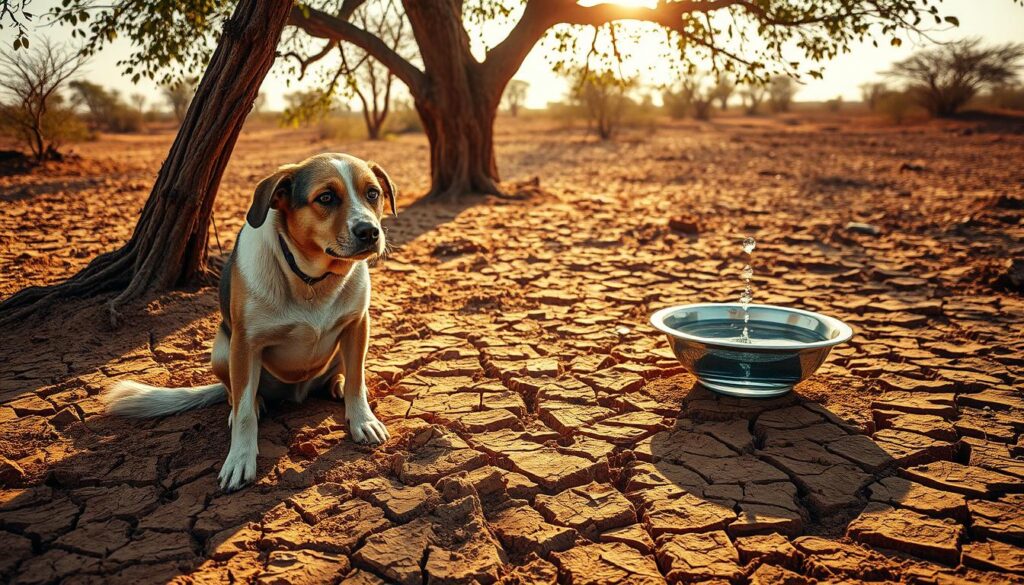Keeping our dogs hydrated is key to their health and happiness. Dogs cannot survive for more than a few days without water, depending on various factors. As pet owners, we must know how much water they need and How Long Can a Dog Go Without Water This article will cover what affects a dog’s water needs, signs of dehydration, and the risks of not drinking enough water.

Key Takeaways
- Dogs cannot survive for more than a few days without water, depending on various factors.
- Factors like age, activity level, health conditions, and environmental conditions affect a dog’s water requirements.
- Signs of dehydration in dogs include lethargy, dry gums, sunken eyes, and decreased skin elasticity.
- Prolonged water deprivation can lead to serious short-term and long-term health consequences, including organ failure and death.
- Ensuring dogs have access to clean, fresh water at all times is essential for their well-being.
Understanding a Dog’s Water Needs
Keeping your dog hydrated is key for their health. The amount of water a dog needs depends on several things. These include their age, size, how active they are, and the weather they live in.
Many things can change how much water a dog needs. For example, bigger dogs need more water than smaller ones. Dogs that are very active or live in hot or dry places also need more water.
Other things like their diet and health can also affect their water needs. Dogs eating dry food might need to drink more than those eating wet or raw food.
Signs of Dehydration in Dogs
It’s important to know the signs of dehydration in dogs. Look out for:
- Dry or sticky gums
- Loss of skin elasticity
- Lethargy or fatigue
- Increased thirst and frequent urination
- Sunken eyes
- Rapid heart rate
If you see any of these signs, make sure your dog has fresh water right away. If it’s really bad, you should take them to the vet.

| Factor | Impact on Water Needs |
|---|---|
| Age | Puppies and senior dogs may have higher water requirements |
| Size | Larger dogs need more water than smaller breeds |
| Activity Level | Active dogs and those in hot/dry climates need more water |
| Diet | Dogs on dry food diets may need to drink more water |
| Health Conditions | Certain medical issues can affect a dog’s hydration needs |
How Long Can a Dog Go Without Water?
Access to clean, fresh water is key for a dog’s health. But how long can a dog safely go without water? Knowing this is crucial for pet owners to avoid serious health issues in their dogs.
A healthy adult dog can usually go without water for 2-3 days. However, puppies, seniors, and dogs with health issues might not last as long. The dog’s size, activity level, and environment also play a role in how long they can survive without water.
| Dog Age | Maximum Time Without Water |
|---|---|
| Puppy | 1-2 days |
| Adult | 2-3 days |
| Senior | 1-2 days |
This time frame is just an estimate. Dogs should never be without water on purpose. Without water, dogs can suffer from severe dehydration, organ failure, and even death. It’s vital for pet owners to keep their dogs hydrated to ensure their health and happiness.

Understanding a dog’s water needs helps pet owners provide the right care. By watching for dehydration signs and ensuring water access, we can keep our dogs healthy and happy for years to come.
Short-Term Effects of Dehydration
Dehydration in dogs can cause serious issues. They might feel tired, eat less, and have dry skin. These problems can get worse fast if they don’t get water soon.
Long-Term Consequences of Water Deficiency
Long-term lack of water can cause big health problems in dogs. It can damage their kidneys and liver. Dogs might also get heat stroke, have imbalances in their body, or even fail organs if they don’t drink enough water.
| Condition | Description | Potential Consequences |
|---|---|---|
| Kidney Dysfunction | Dehydration can strain the kidneys, leading to impaired filtration and waste removal. | Increased risk of kidney stones, kidney disease, and ultimately, kidney failure. |
| Liver Damage | Dehydration can disrupt the liver’s ability to function properly, affecting vital metabolic processes. | Impaired liver function, leading to a range of health issues, including digestive problems and toxin buildup. |
| Electrolyte Imbalance | Prolonged water deprivation can cause a imbalance of essential electrolytes, such as sodium and potassium. | Cardiac arrhythmias, muscle weakness, and neurological symptoms, potentially leading to life-threatening complications. |
Preventing Dehydration in Dogs
Keeping your dog hydrated is key to their health. To avoid dog dehydration symptoms, make sure they always have clean, fresh water.
Providing Adequate Water Access
Here are some tips to help ensure your dog stays properly hydrated:
- Place water bowls in multiple locations around your home and backyard, making it easy for your dog to access water throughout the day.
- Regularly clean and refill the water bowls, ensuring your dog always has access to clean, fresh water.
- Consider investing in a water fountain or automatic waterer, which can encourage increased dog water intake and maintain a consistent supply of fresh water.
- When traveling with your dog, pack a portable water bowl and make sure to offer water breaks frequently to prevent dehydration.
- Monitor your dog’s water consumption and adjust the amount of water provided based on their individual needs, taking into account factors such as age, activity level, and weather conditions.
By addressing your dog’s hydration needs early, you can keep them healthy and happy. This helps avoid the dangers of dehydration.
| Factors Affecting Dog Hydration | Recommended Daily Water Intake |
|---|---|
| Size and breed | 0.5 to 1 ounce per pound of body weight |
| Age and activity level | Puppies and active dogs may need more |
| Environmental conditions | Increased intake during hot, dry, or humid weather |
| Overall health and medical conditions | Consult with your veterinarian for personalized recommendations |
Conclusion
Understanding a dog’s water needs is key for their health. Recognizing dehydration signs is also important. By following the guidelines in this article, pet owners can keep their dogs hydrated.
Knowing how long a dog can go without water is crucial. Being aware of dehydration signs helps pet owners act fast. Providing clean, fresh water and watching their intake is easy to do.
By focusing on a dog’s hydration, pet owners improve their life quality and longevity. Staying informed and watching their water intake is caring. It greatly affects their comfort and energy.
FAQ
How long can a dog go without water?
The time a dog can go without water depends on several factors. These include their age, size, how active they are, and the weather. Generally, a healthy adult dog can last 2-3 days without water. But, it’s crucial to make sure they always have clean, fresh water to avoid health problems.
What are the signs of dehydration in dogs?
Signs of dehydration in dogs include dry or sticky gums and being very tired. They might also have less elastic skin, not want to eat, and have sunken eyes. If you see these signs, give your dog water right away and watch them closely.
How much water should a dog drink per day?
The amount of water a dog needs daily depends on their size, breed, how active they are, and the weather. Dogs usually need about 1 ounce of water for every pound of body weight each day. But, make sure they always have access to clean water and watch how much they drink.
What happens if a dog goes too long without water?
If a dog doesn’t get water for too long, they can get very dehydrated. This can cause serious health problems, like organ damage and kidney issues. It’s very important to know the signs of dehydration and act fast to help your dog.
How can I prevent dehydration in my dog?
To keep your dog from getting dehydrated, make sure they always have clean water. This is true at home and when you’re out. Watch how much water they drink, especially when it’s hot or they’re more active. Also, know the signs of dehydration and get vet help if you see any.
